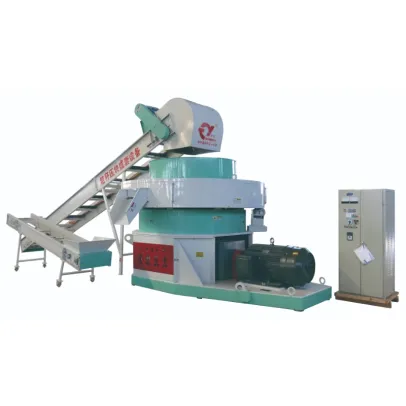Types of Biomass Briquette Machines
Currently, there are two main types of briquette machines in China: disk extrusion briquette machines and piston press briquette machines. Disk extrusion briquette machines are further categorized into three types: ring die, flat die, and ring-flat die. The products produced by disk extrusion briquette machines are small in volume, with a cross-section generally around 30MM*30MM. They operate with high-speed, high-frequency impacts, striking approximately 300 times per minute. Depending on the density of the straw, they can produce about 0.8 to 1.2 tons per hour of compacted straw rods with a diameter of 70mm or 80mm and a density of 1 to 1.25 g/cm3. The shapes of the straw rods can vary, including round, square, and hexagonal, and can even have a hole in the middle. Customizations can be made according to customer requirements.
A biomass briquette machine compresses crushed raw materials into pellet or rod-shaped products, primarily used as fuel or animal feed. These machines are also known as wood pellet machines, sawdust pellet machines, wood powder pellet machines, straw pellet machines, corn straw pellet machines, biomass briquette machines, rice husk pellet machines, organic fertilizer pellet machines, feed pellet machines, and straw coal forming machines. The main types are vertical ring die pellet machines, flat die pellet machines, and horizontal ring die pellet machines.

Biomass briquette machines effectively solve the issue of difficulty in pelletizing coarse biomass fibers and poor results. The main machine uses a high-standard heavy-duty gearbox transmission, with high-quality bearings for all transmission parts, ensuring efficient, stable, low-noise, and durable transmission. The ring die adopts a quick-release clamp type, and feeding uses frequency conversion speed control to ensure uniform feeding. Our company’s wood pellet machines are manufactured using advanced international manufacturing techniques, and the “press roller” is made of high-alloy wear-resistant materials.
Performance Features of Biomass Briquette Machines:
1. High centrifugal efficiency and high pressure, suitable for materials that are difficult to press.
2. Low wear rate, with long service life for press rollers and die plates.
3. Fully automatic lubrication system allows continuous operation without stopping.
4. Vertical structure of the die, with direct feeding, high efficiency, and good heat dissipation.
5. Long service life of the die plate: The mold is made of alloy steel with special processing technology, resulting in a hard and wear-resistant surface with a tough core, and high low-temperature impact toughness.
6. High performance ratio and cost-effectiveness: The technology content and functionality have been improved based on similar equipment, with the price considering the affordability of a broad range of users, especially farmers.
Applicable Scope of Biomass Briquette Machines:
Biomass briquette machines are suitable for pressing materials that are difficult to bond and shape, such as rice husks, sunflower seed shells, peanut shells, and various fruit shells; branches, trunks, bark, and other wood scraps; various crop straws; and various chemical raw materials like rubber, cement, and ash.
This comprehensive overview provides insight into the various types and features of biomass briquette machines, helping users select the most suitable model for their specific needs.

Comments
0